Mariani's Virtual Gourmet Newsletter
May 22, 2011

"Big" (1988) with Tom Hanks
This
Week
Iceland, Part Two
by John Mariani
New York Corner: Bedford Post Inn
by John Mariani
Man About Town: An Auction
That Bids Down In Price?
by Christopher Mariani
At Ravenswood, the Godfather of
Zinfandel Searches for
Identity
by Brian Freedman
Quick Bytes
called "Eat Like a Man," which will be featuring restaurant
articles by John Mariani and
others
from around the USA:
An
Ode
(Sort
of)
to
the
Closing of Elaine's
❖❖❖
ICELAND
Part Two
by John Mariani

The
Northern Lights above Reykjavik
Iceland
only
has
a
few
towns
that
rise
to
the
name
city, and the capital of
Reykjavik,
founded in the 9th century,
never seems exactly bustling. The whole country
only has 300,000 people, and two-thirds of them live around Reykjavik.
Little
traffic means little noise, and wherever you are, you sleep in windy
silence.
If, as shown in the photo above, you are there when Nature conspires to
bring up the Northern Lights, you will see something as rare and
wondrous as when Eric the Red arrived here.
It is a city with a good number
of tourist sights for its size, and it is as handsome as its people,
who come from Norwegian and Celtic stock. There are art museums,
natural
history museums, a Viking Village, opera, theater and year-round music
festivals. Evereybody, and I mean everybody,
speaks
perfect
English.
 It is definitely a walking city, in the
downtown streets, lined with shops and boutiques, with many local
designers of clothes and jewelry, and you can stroll around most of it
in a couple of hours, along the waterfront, up to the extraordinary Church
of
Hallgrímur—or
Hallgrímskirkja--with
its
244-foot
steeple,
the
tallest
building in Reykjavík (left).
In summer the climate is a lovely 15 degrees C (59 F), so the sea does
not get warm enough to swim in. But summering on the beaches and
trekking through the mountains and glaciers is wildly popular. After
months under long, dark days, Icelanders crave the sun like wildflowers.
It is definitely a walking city, in the
downtown streets, lined with shops and boutiques, with many local
designers of clothes and jewelry, and you can stroll around most of it
in a couple of hours, along the waterfront, up to the extraordinary Church
of
Hallgrímur—or
Hallgrímskirkja--with
its
244-foot
steeple,
the
tallest
building in Reykjavík (left).
In summer the climate is a lovely 15 degrees C (59 F), so the sea does
not get warm enough to swim in. But summering on the beaches and
trekking through the mountains and glaciers is wildly popular. After
months under long, dark days, Icelanders crave the sun like wildflowers.
Iceland has, of course, suffered a double whammy in
recent years, with its economy collapsing in 2008 (the joke at the time
was, “What’s the
difference between Iceland and
Ireland? Answer: One letter and about six months.”), and then the
volcano Eyjafjallajökull
exploded.
But,
as
Paul
Krugman
of
the
NY Times
explains, "Iceland let foreign
lenders to its runaway banks pay the price for their poor judgment,
rather than
putting its own taxpayers on the line to guarantee bad private debts,"
and "unlike Ireland, Iceland still has its own currency; devaluation of
the krona,
which has made Iceland’s exports more competitive, has been an
important factor
in limiting the depth of Iceland’s slump." So while the economy
has not completely rebounded, the country is in pretty good shape, and
that
volcano eruption helped enormously in drawing tourists who want to see
what all that was about. (See Part
One of this article for further info
on the effects of
Eyjafjallajökull.)
Reykjavik has plenty of small hotels.
The grandest in town is the Hotel Borg, with 56
room, though I stayed at one of the best new hotels in town, 101 smack in the center of town and
convenient to
everything within blocks. Modern, minimalist and very comfortable, with
large rooms and big bath/shower, 101 (right) also offers a fine breakfast
in the morning to get you started and the lounge is arrayed with
hundreds of international design and fashion magazines for your
perusal.
I had a chance to visit  The
Laugar
Spa
(left), rightly one of the
city's most popular attractions,
constantly filled with locals who come for a work-out and then steam in
a
series of shadowy, echoing rooms.
The
Laugar
Spa
(left), rightly one of the
city's most popular attractions,
constantly filled with locals who come for a work-out and then steam in
a
series of shadowy, echoing rooms.
The
Blue
Lagoon, about 40 minutes drive from the capital, is
where, with stamina, you can go for a cold dunk and
splash around in the icy water, if that makes you happy.
There's a spa by that name with all the treatments
and relaxants to the body and spirit you could ask for.
You’ll
find every kind of restaurant in the city—even Indian kebab houses and
sushi—while Iceland's native cuisine is largely built around reindeer
venison, lamb,
and seafood, including lusciously sweet langoustines.
Reindeer were
brought in from Norway in the 18th century and now all
run wild. The lamb is all raised in Iceland.
There
is
a
Christmas
tradition to serve ptarmigan, a
very gamy wild bird that is hunted (but may not be sold) in
Iceland.
A local favorite—well, actually not all that many
Icelanders crave the stuff—is called “stinky shark,” which is fermented
by
having a group of guys piss on the dead fish, then burying it to
acquire a
taste that my guide said “tastes like very strong cheese.” I passed.
There
is,
as
everywhere
in
the
world
these
days,
a
vibrant young crowd of
chefs in Reykjavik who are forging what they call a New Nordic
Cuisine. Exemplary of this movement is VOX Restaurant,
which actually published its own manifesto on the subject, including
the
following precepts:
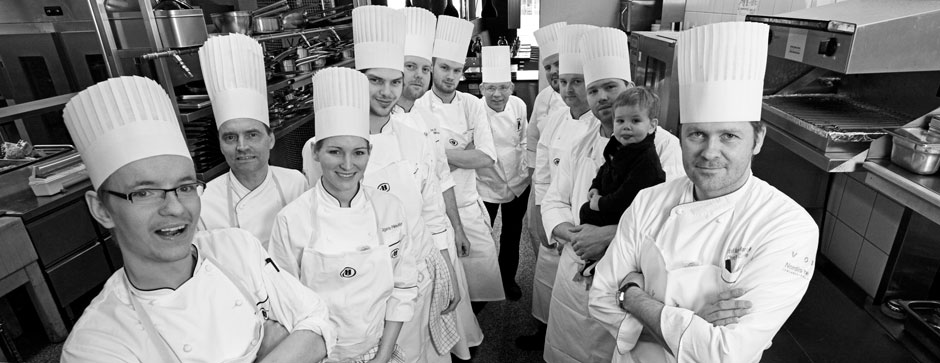
● To express the purity, freshness, simplicity and ethics that we would
like to associate with our region.
● To reflect the different seasons in the meals.
● To base cooking on raw materials whose characteristics are especially
excellent in our climate, landscape and waters.
● To combine the demand for good taste with modern knowledge about
health and well-being.
● To promote the Nordic
products and the variety of Nordic producers – and to disseminate the
knowledge of the cultures behind them.
● To promote the welfare of the animals and a sound production in the
sea and in the cultivated as well as wild landscapes.
● To develop new possible applications of traditional Nordic food
products.
●
To
combine
the
best
Nordic
cooking
procedures
and
culinary
traditions
with impulses from outside.
●
To
combine
local
self-sufficiency
with
regional
exchange
of
high-quality
good
cooperate with
representatives of consumers, other cooking craftsmen, agriculture,
fishing industry, food industry, retail and wholesale
industry,
researchers, teachers, politicians and authorities on this joint
project to the benefit and advantage of all in the Nordic countries.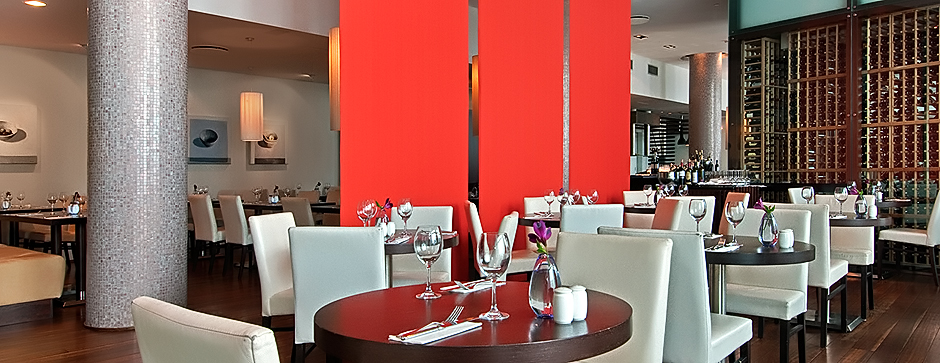
Vox
has a Gourmet Restaurant and a more casual
Bistro (right), where I dined
one afternoon. It was a buffet, not my favorite way to
eat, but it did give me a sense of the exceptional range of the kitchen
under
chef de cuisine Stefán Viðarsson (above, on the far right, with kitchen
brigade), from Nordic-style sushi and sashimi of
unstinting freshness to some well-wrought pastas. There
was
a
smørrebrød
of
fried
plaice
on rye
bread
with
rémoulade and pickled
cucumbers, and an array of Nordic tapas ,
including shrimp, smoked salmon, herring, caviar, bread. Among the myriad desserts offered, the
one not to miss is the whipped sky, an Icelandic cheese, with meringue, cherries, toffee ice cream.
 One of
the most popular restaurants in the city, since 2008, is the Fish Company (left), whose building dates back to
1884, originally set elsewhere but now on its present location at Grófartorg.
The
heritage
of
the
building
is
incorporated
into
“The
Tides,” a
work of art by Hjörleifur Stefánsson; the restaurant was designed
by Leif Welding and master chef Lárus Gunnar
Jónasson, with window
panes from the Hafnarfjörður Free Lutheran Church backlit
behind
the bar; signature china is from Figgijo in Norway, and many of the
items used in the restaurant, china and kitchenware alike, are on
display and for sale in the outer hall.There's also a wall of food
photos and on the way out Post-Its and notes from fans who love Fish
Company's happy atmosphere and good food.
One of
the most popular restaurants in the city, since 2008, is the Fish Company (left), whose building dates back to
1884, originally set elsewhere but now on its present location at Grófartorg.
The
heritage
of
the
building
is
incorporated
into
“The
Tides,” a
work of art by Hjörleifur Stefánsson; the restaurant was designed
by Leif Welding and master chef Lárus Gunnar
Jónasson, with window
panes from the Hafnarfjörður Free Lutheran Church backlit
behind
the bar; signature china is from Figgijo in Norway, and many of the
items used in the restaurant, china and kitchenware alike, are on
display and for sale in the outer hall.There's also a wall of food
photos and on the way out Post-Its and notes from fans who love Fish
Company's happy atmosphere and good food. 
As should be obviously, the food is proudly
Icelandic, and a good way to appreciate that is to go with the tasting
menu of tea-marinated fillet of cod and garlic with roasted
langoustine--langoustines are very large in Icelandic waters--roasted
artichoke puree, fennel, and spiced bread, and
lobster with Hollandaise sauce; Arctic char and dried salted salmon
with walnut powder, salmon roe, dill oil, mustard sauce and malt ice
cream; thyme-scented rack of lamb and salted mutton with pearl onions
in crowberry, caramelized turnip puree and crispy leek and bacon roll;
for dessert, blueberry pudding with chopped caramel chocolate, sky,
yogurt and lime sorbet and white chocolate. Quite a bargain at about
$75. The wine list is surprisingly global, with bottles from
Europe, Australia, and Africa.
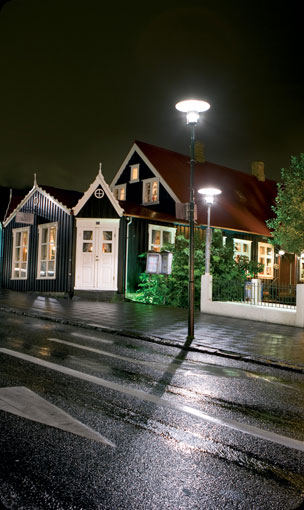 Lækjarbrekka is a
very different kind of restaurant, old-fashioned in
the loveliest sense, set within a house that dates to 1834 as the
house
of Danish ship owner and merchant P.C Knudtzon, who also ran a
bakery there. The baker in turn bought the house in 1845 and
prospered
as the only baker in town for years.
The building was used as a dwelling until 1961 and a small shop was
there until
the time of reconstruction began in 1980, upon being declared a
protected
historic building, turned into the restaurant in 1979.
Lækjarbrekka is a
very different kind of restaurant, old-fashioned in
the loveliest sense, set within a house that dates to 1834 as the
house
of Danish ship owner and merchant P.C Knudtzon, who also ran a
bakery there. The baker in turn bought the house in 1845 and
prospered
as the only baker in town for years.
The building was used as a dwelling until 1961 and a small shop was
there until
the time of reconstruction began in 1980, upon being declared a
protected
historic building, turned into the restaurant in 1979.
It is now very beautiful,
evocative of an older time, done in antique furnishings
and artwork, quiet, civilized but unpretentious. I recommend either the
"Icelandic Langoustine Feast" ($75) or the Icelandic Lamb Feast
($70), both very popular here (there is also à la carte). The
first
menu
features langoustine soup with a taste of cognac and lightly whipped
cream;
langoustines in three ways, grilled in garlic butter, deep fried in
tempura and
pan fried with saffron cream; and for dessert, a three-color parfait
with
crunchy praline base.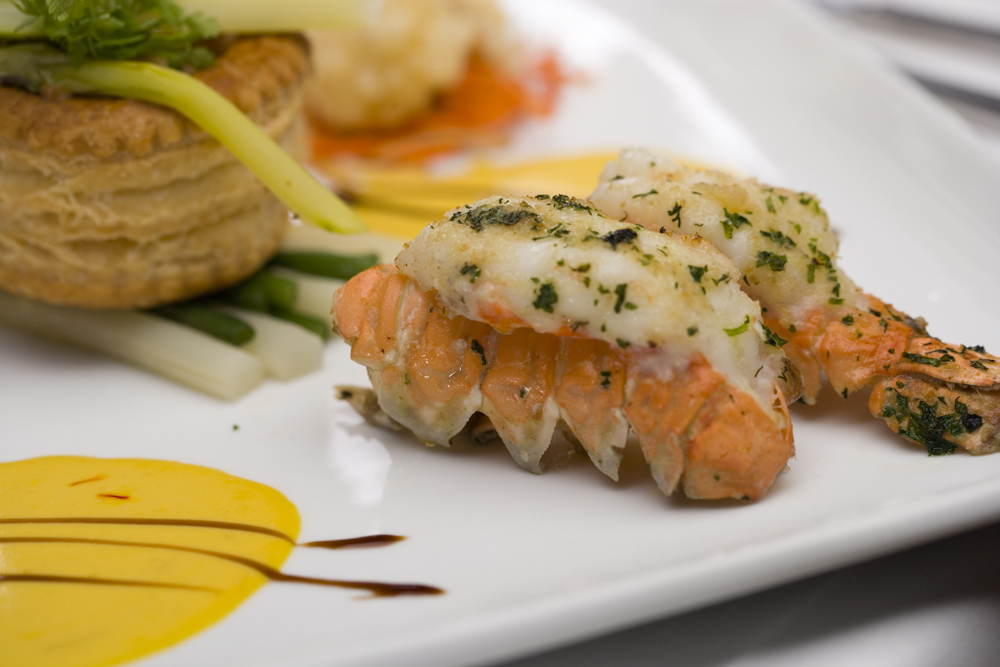
The Icelandic Lamb feast begins with a carpaccio of lamb, smoked and herb cured lamb with crispy salad and blueberry vinaigrette, then lamb in two ways, pan fried fillet and slow cooked shoulder served with crunchy potatoes and thyme sauce, with an ending of chocolate special dessert. Linger over the last of the wine or a glass of Cognac, step outside, breathe in the freshest air imaginable, and take a languorous walk back to your hotel. You will sleep as well as any baby that night in Reykjavik.
BARS: An Icelandic tradition is the midnight pub crawl called a runtur, which can end around 4 AM. The 101 Hotel, where I stayed, has a sleek, modern bar. The ten-year-old NASA goes strong as the most popular hangout in Reykjavik for live music. B5 is a hip spot with a light bistro menu and Philippe Starck décor. Thorvaldsen Bar gets a late-night weekend crowd and serves Icelandic-Asian food.
HOW
TO
GET
THERE
Icelandair flies
nonstop from New
York to Keflavik International Airport about 40 minutes from Reykjavik. This
summer Air Berlin
will
fly to Iceland from Hamburg, Berlin, Stuttgart, Düsseldorf, Munich
and Vienna,
while Iceland Express will add Chicago and Boston to its destinations.
Delta
Air Lines announced its plans to commence direct flights between
Iceland and
New York. A taxi from
the airport , a good 40 minutes from the capital, can cost about $110,
but Reykjavik Excursions runs
buses
for
about
$14
each
way.
❖❖❖
NEW YORK CORNER
 BEDFORD
POST INN
BEDFORD
POST INN
954 Old Post
Road,
Bedford, NY
914-234-7800
www.bedfordpostinn.com
Hollywood has always
loved
the idea of naive characters from the city who get into
enormous
difficulties upon moving to the country, ever since "Mr. Blandings
Builds His Dream House" up through "Beetlejuice" and "The Money Pit,"
not to forget when
Lucy and Ricky moved to Connecticut to raise chickens in the "I Love
Lucy
Show." Of course, plenty of show biz stars who do in fact live
way out from town, not least Keith Richards, who, oddly enough, lives
in
Connecticut. The late Paul Newman resided in Westport,
where he
supported both the local Playhouse and a fine restaurant there called
the
Dressing Room. So it was not quite unique for actors- and-married
couple
Carey
Lowell and Richard Gere, together with partner Russell
Hernandez,
to open the eight-room
Bedford Post Inn and spa on an historic 19th century property in
Bedford, New
York, about 45 minutes’ drive from Manhattan in Westchester
County. That
was three years ago and the place does very well in every season; I'm
sure
guests hope the Geres might some nights drop by to see how their
investment is
faring (they do).
It's a very beautiful place in a superb and bucolic
location, its décor largely Carey's doing. At the downstairs
Barn (below), they serve
breakfast and lunch weekdays, dinner Monday and Tuesday, and brunch on
the
weekend, with its Bakery open daily. Upstairs is the dining room
called
the 75-seat Farmhouse (below)
, with wainscoting, buffed wooden floors, antique tables set with
breadbaskets, and well-spaced tables laid with soft linens, fine
stemware, and
good silverware. Earlier in the evening the lighting is glowing
and
amiable, but for some reason later on they turn out down to become dark
and far
less congenial. 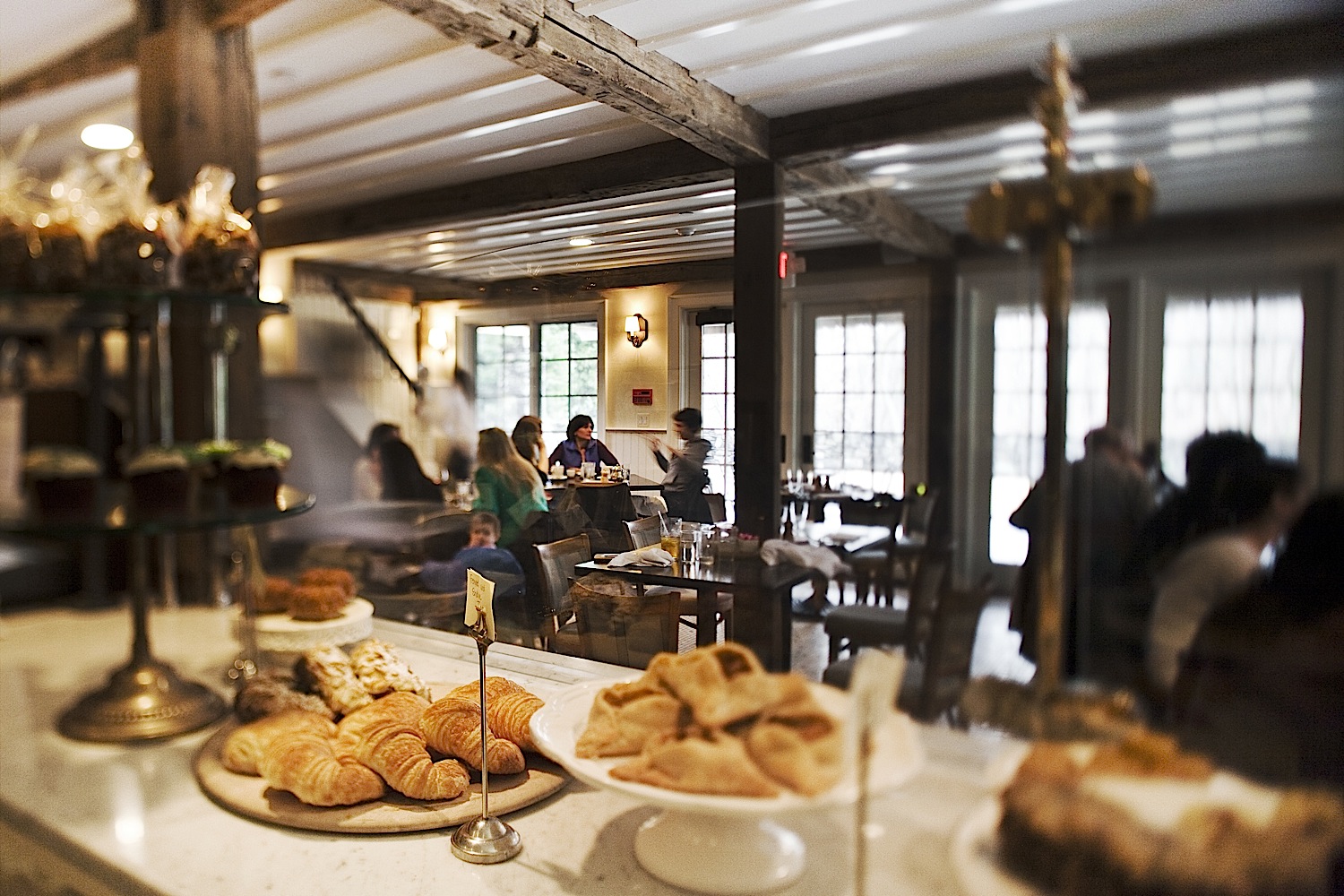
The Farmhouse's first chef, Brian Lewis, worked in a
modern
American style, incorporating global influences into his seasonal
menus.
The new chef is Jeremy McMillan, who continues much in the
same
style, a balance between the rustic and the refined, as evidenced in
the
mushroom minestra in a parmigiano broth with wild nettle
pesto. There is
a section of crudi, raw
items, including, when at their best, fluke with tangerine, green
olive and almonds; striped jack is pretty with onion blossoms, blood
orange, and pistachio; well-fatted swordfish belly comes with
Mediterranean flavors of dried tomato and salmoriglio sauce of olive oil
garlic, herbs, and lemon; and
beef with ramps, pecorino cheese, and a toasted baguette.
An appetizer of mozzarella with rhubarb mostarda and almond
pesto is excellent, and simple spring vegetables come with a whipped
ricotta and a tangy citron vinegar. There is a pasta
section, all of them
rendered with authenticity, from linguine nero with King crab, pickled
chilies
and mint to fat agnolotti with
rich
veal,
porcini, ramps and parmigiano
stuffing. A simple spaghetti is treated to a tomato sauce is spiked
with
crushed
peperoni and pecorino cheese.
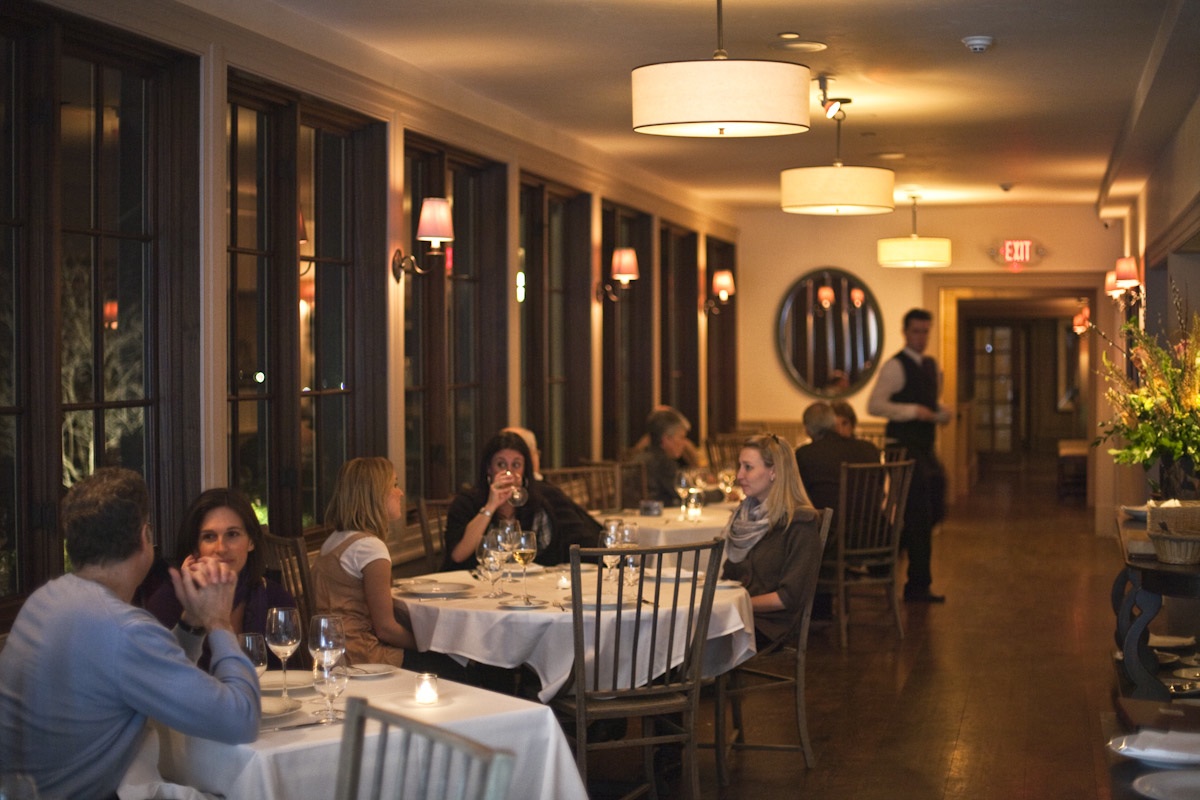 The night I visited I
was delighted with the quality of
the swordfish with baby fennel, lemon, and capers, all complementing
each
other and as fresh as the sea, while dry-aged beef was first rate, with
pearl
onions, arugula and a glaze of balsamic. Tender, flavorful veal
came
with lovely green fava beans, spring onions in a bagnet vert (green sauce), and
“John Boy’s
Chicken” (named for a former Wall Street broker who, after 9/11, sought
a quiet
life raising chickens and pigs in the Berkshires, supplying the Inn
with many
of their ingredients) was crisply roasted and accompanied by potato
with
pickled ramps and sweet chilies. In
some of McMillan's dishes, the
seasonings were a little tame, and added salt and pepper enhanced more
than
one dish.
The night I visited I
was delighted with the quality of
the swordfish with baby fennel, lemon, and capers, all complementing
each
other and as fresh as the sea, while dry-aged beef was first rate, with
pearl
onions, arugula and a glaze of balsamic. Tender, flavorful veal
came
with lovely green fava beans, spring onions in a bagnet vert (green sauce), and
“John Boy’s
Chicken” (named for a former Wall Street broker who, after 9/11, sought
a quiet
life raising chickens and pigs in the Berkshires, supplying the Inn
with many
of their ingredients) was crisply roasted and accompanied by potato
with
pickled ramps and sweet chilies. In
some of McMillan's dishes, the
seasonings were a little tame, and added salt and pepper enhanced more
than
one dish.
I heartily recommend the farmstead and artisanal
cheeses offered
here in peak condition, with some of the best bread served in the
region. Otherwise, go with the yogurt panna
cotta,
which is nice and light, or the rich
and decadent chocolate-hazelnut gianduja mousse with cocoa nibs and
chocolate sauce.
The 2,500 bottle wine list at BPI continues to be a
very good one, but
prices, even for this tony neighborhood, are high, a list in need of
more
selections under $60.
At just about any time of year the Inn has its
distinct charms, from the snowy drifts of winter and the foliage of
fall, but right now, with everything in the garden and the surrounding
woods in bloom, the idea of driving up to Bedford is a wonderful
outing. The Geres and their partners did it right.
The Farmhouse is open Wed.-Sun.
for dinner only. Dinner appetizers run $12-$15, pastas $17-$23, main
courses $29-$39.
There is a five-course menu at a very reasonable $65 and eight courses
for an
even more reasonable $95.
❖❖❖

MAN ABOUT TOWN
by Christopher Mariani
An Auction That Bids Down In Price?
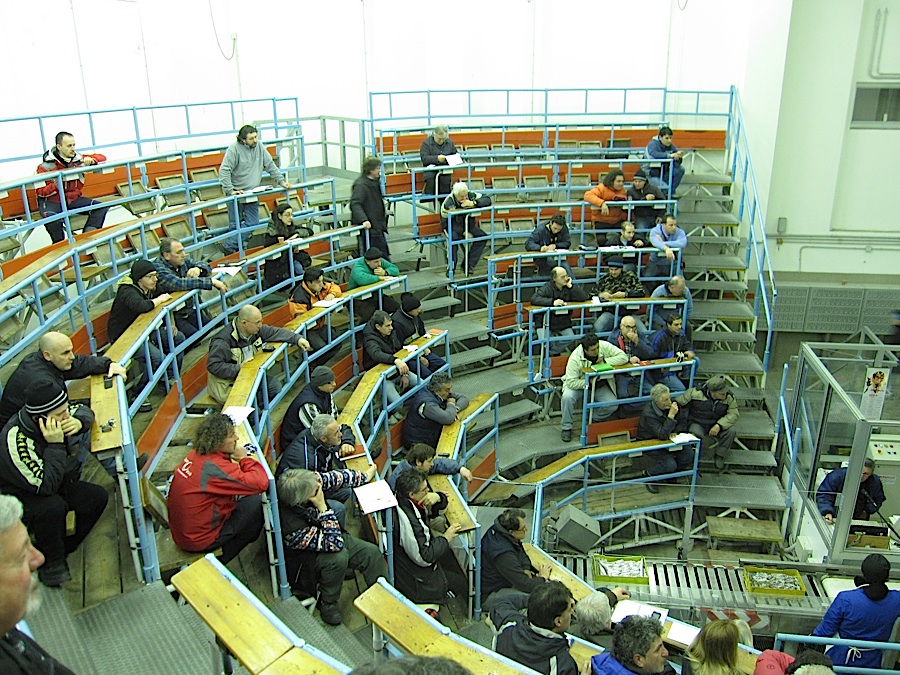 Auctions
of any sort are typically notorious for their incessant auctioneers
speaking in almost unrecognizable tongues, intense emotion among
potential buyers
and the
price of an item increasing until the highest bidder is finally awarded
as the
victor. Yet, when I attended a fish auction at the market of
Fano in the Le Marche region of Italy, the
auctioneer barely spoke, buyers sat quietly as trays of seafood from
the
Mediterranean were presented and the price of the catch decreased
during the
bid process. I thought to myself, this doesn’t make sense, why does the
price
drop?
Auctions
of any sort are typically notorious for their incessant auctioneers
speaking in almost unrecognizable tongues, intense emotion among
potential buyers
and the
price of an item increasing until the highest bidder is finally awarded
as the
victor. Yet, when I attended a fish auction at the market of
Fano in the Le Marche region of Italy, the
auctioneer barely spoke, buyers sat quietly as trays of seafood from
the
Mediterranean were presented and the price of the catch decreased
during the
bid process. I thought to myself, this doesn’t make sense, why does the
price
drop? As part of an annual GRI (Gruppo Ristoratori Italiani) educational trip to Italy, hosted by Tony May, owner of NYC’s SD26, I attended a fish auction very early one morning. The phone rang at 3:15 a.m. and I turned over in my bed to answer. The voice on the other end said, “Signore Mariani, this is your wake up call. Would you like a follow up call in 15 minutes?” I responded in a coarse voice, “No thank you,” then hung up the phone. I sat up, rubbed my eyes, then got dressed. After a quick espresso in the lobby of the Hotel Savoy in Pesaro, we headed for the market in the darkness of the young morning.
After a short nap on the bus, we arrived. Fishermen were unloading their fish and placing them neatly on display inside trays layered with shaved ice stacked about four feet high. The tile floor was wet from ice that had melted and the loading room smelled of fish. We then entered the auction room (above). In the center of the room was a conveyor belt presenting tray
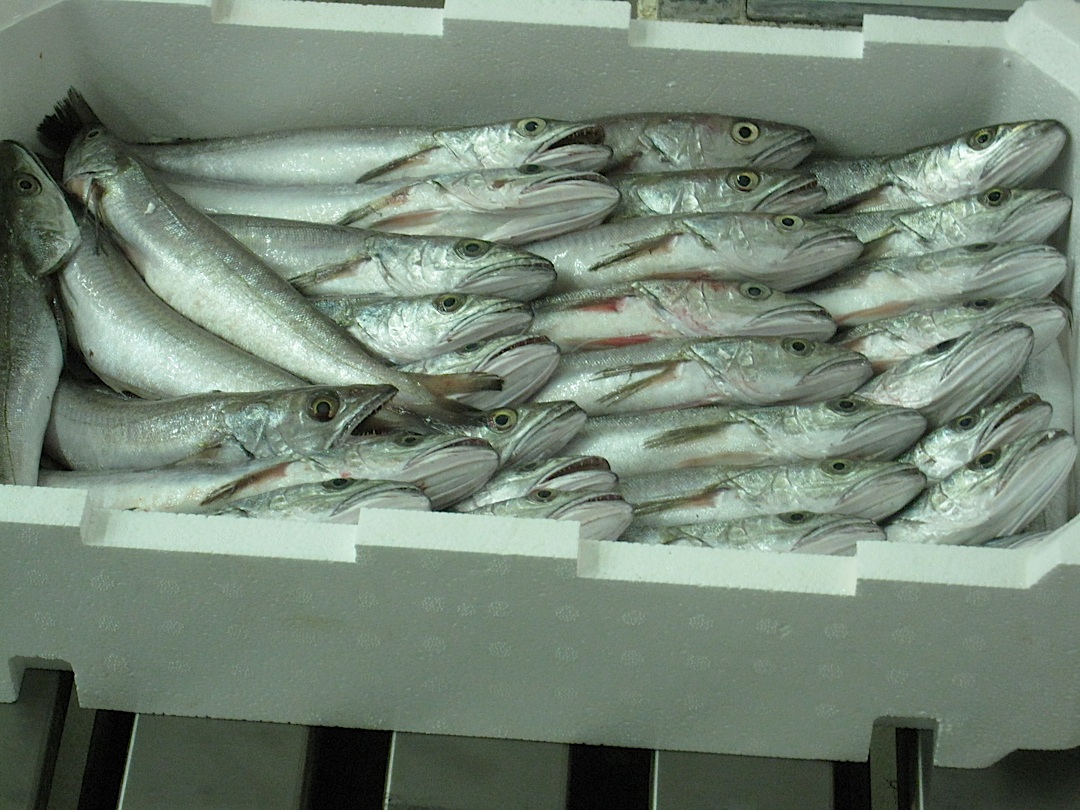 after
tray
of fish, a scale
that calculated the weight of each tray and around the display a steep
semi-circle seating forum that sat no more 70 people that morning. The
seats
were not all that comfortable. There was an old wooden wrap around desk
in
front of the seats most men used to lean their elbows on.
Underneath the
wooden desk were small buttons used to discreetly bid on desired trays
of
fish.
after
tray
of fish, a scale
that calculated the weight of each tray and around the display a steep
semi-circle seating forum that sat no more 70 people that morning. The
seats
were not all that comfortable. There was an old wooden wrap around desk
in
front of the seats most men used to lean their elbows on.
Underneath the
wooden desk were small buttons used to discreetly bid on desired trays
of
fish. Trays of gorgeous scampi, triglie (mullet), granchio (crab), sardines and other species of small fish came out on the conveyor belt in no particular order. The process of bidding began when a tray of seafood would make its turn onto the weight scale. The price in Euros, per kilo, would display in red on a large electronic board (below) mounted on the wall. The auctioneer would speak into a microphone to state the type of fish on the scale and its starting price. The price on the board would then slowly begin to drop as a circular sequence of lights surrounding the starting price would move in a counter-clockwise direction. When a potential buyer was happy with the adjusted price, he would then press his discreet button and the tray was his.
 The
question still remains, why does the price drop? The price drops
because the fisherman
selling the fish set the initial price very high. They of course hope
the set
price will be the sell price, but they are well aware
the price
they have set is inflated. As the price begins to drop, restaurateurs
and potential
buyers have three questions to ask themselves. What is a reasonable
price for
the fish by kilo? How many other people in the room desire this same
tray of
seafood? And, how many trays of this specific fish are there? The first
buyer
to press the button is the one who gets the fish. So you must be aware
of the
others buyers in the room and what they are willing to pay for such a
catch.
There is a strategy to this bid system, far more intricate than just
out-bidding your competitor. One obviously does not want to overpay for
a tray
of fish, but on the other hand, does not want to lose a tray of fish to
a
fellow bidder if there are a limited amount of that particluar fish in
the
loading room.
The
question still remains, why does the price drop? The price drops
because the fisherman
selling the fish set the initial price very high. They of course hope
the set
price will be the sell price, but they are well aware
the price
they have set is inflated. As the price begins to drop, restaurateurs
and potential
buyers have three questions to ask themselves. What is a reasonable
price for
the fish by kilo? How many other people in the room desire this same
tray of
seafood? And, how many trays of this specific fish are there? The first
buyer
to press the button is the one who gets the fish. So you must be aware
of the
others buyers in the room and what they are willing to pay for such a
catch.
There is a strategy to this bid system, far more intricate than just
out-bidding your competitor. One obviously does not want to overpay for
a tray
of fish, but on the other hand, does not want to lose a tray of fish to
a
fellow bidder if there are a limited amount of that particluar fish in
the
loading room. After the auction ends, about two hours later, many of the fisherman and buyers head down the street to a small café for a fisherman drink known as a moretta, made with espresso, sugar, lemon, rum, anisette and either cognac or brandy. I had one moretta and then proceeded back to my hotel for a little sleep before I woke and toured the stunning seaside city of Pesaro, but that’s a story for another time.
To contact Christopher Mariani send an email to christopher@johnmariani.com
❖❖❖
NOTES FROM THE WINE
CELLAR
by Brian A.
Freedman
In
a
world
of
so
many
over-extracted
wines whose main selling points are
their
high alcohol, glass-staining color the opacity of a black hole, and
fruit so
extracted it’s often perceived as sweet, consumers could be forgiven
for
assuming that Ravenswood’s wines fit neatly into this category. The
name is as
close to synonymous with zinfandel--that rich, exuberant grape--as any
other
producer’s in the world, and their motto, “No Wimpy Wines,” could be
perceived
to imply that the goal is richness at all costs.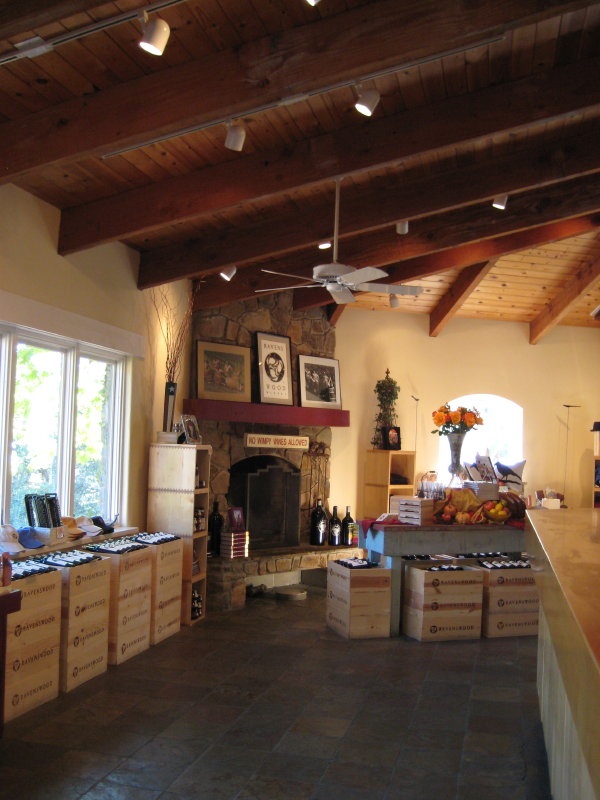
But to assume so would be to miss the point completely. For though Ravenswood does produce a number of show-stoppers, it’s also capable of bottling some of the most nuanced, terroir-expressive zinfandels in the world today. Its Vineyard Series, in particular, demonstrates exactly how detailed these wildly expressive wines can be, and how much more California has to offer than most people give it credit for.
It wasn’t always this way. When Joel Peterson (below), affectionately known as the Godfather of Zinfandel, first started out making wine on the side during his previous career as a researcher in cancer immunology, none of the success he has since seen was a foregone conclusion--or even, for that matter, terribly likely.
“Zinfandel has actually had some ups and downs in its life,” Peterson said. “I keep a framed copy of an article on my wall just to remind me. It’s from The New York Times, and it’s labeled, ‘Zinfandel: Beloved No Longer.’ It’s from, like, 1977, I think. Obviously [now], zinfandel is much more beloved than it was at that particular moment in time.”
That, of course, is a huge understatement, and in the more than three decades since then (the first wines that Peterson ever released were single-vineyard zinfandel bottlings from the 1976 vintage), Peterson has led the way toward the widespread acceptance, and even veneration, of American’s great red grape variety.
It hasn’t always been easy. Peterson stressed to me that, as is the case with so many wines (and spirits and beers), producers tend to chase scores, to craft wines that they believe will make the biggest impact when the critics taste them. “Zinfandel is probably more subject to that than many other varieties, because it doesn't have a referential place from which it’s difficult to differ too much without confounding expectations," he said. "Bordeaux, for example, is generally the benchmark for cabernet, Burgundy for pinot noir, and so on. But zinfandel really doesn’t have anything like that, so it searches for its identity, which I think is getting stronger.”
Peterson noted that, in the 1970s, zinfandels were often produced in a way that was “very high in alcohol, usually had some residual sugar, and had enough tannin in them to preserve [them], and those fell out of favor because once the fruit dropped out, they were just these kind of hollow, harsh-tannin shells,” he said.
From there, as pendulum began to swing in the other stylistic direction, a more balanced style of zinfandel emerged--what Peterson called a “Claret style” that demonstrated “a good balance of acid and tannins and pretty fruit.” There’s been some back and forth over the years, as there is with all grape varieties and regional styles, but these days, Peterson sees zinfandel as finding its sweet spot in this more even-keeled incarnation, which results in wines that are just as delicious on their own as they are paired with food.
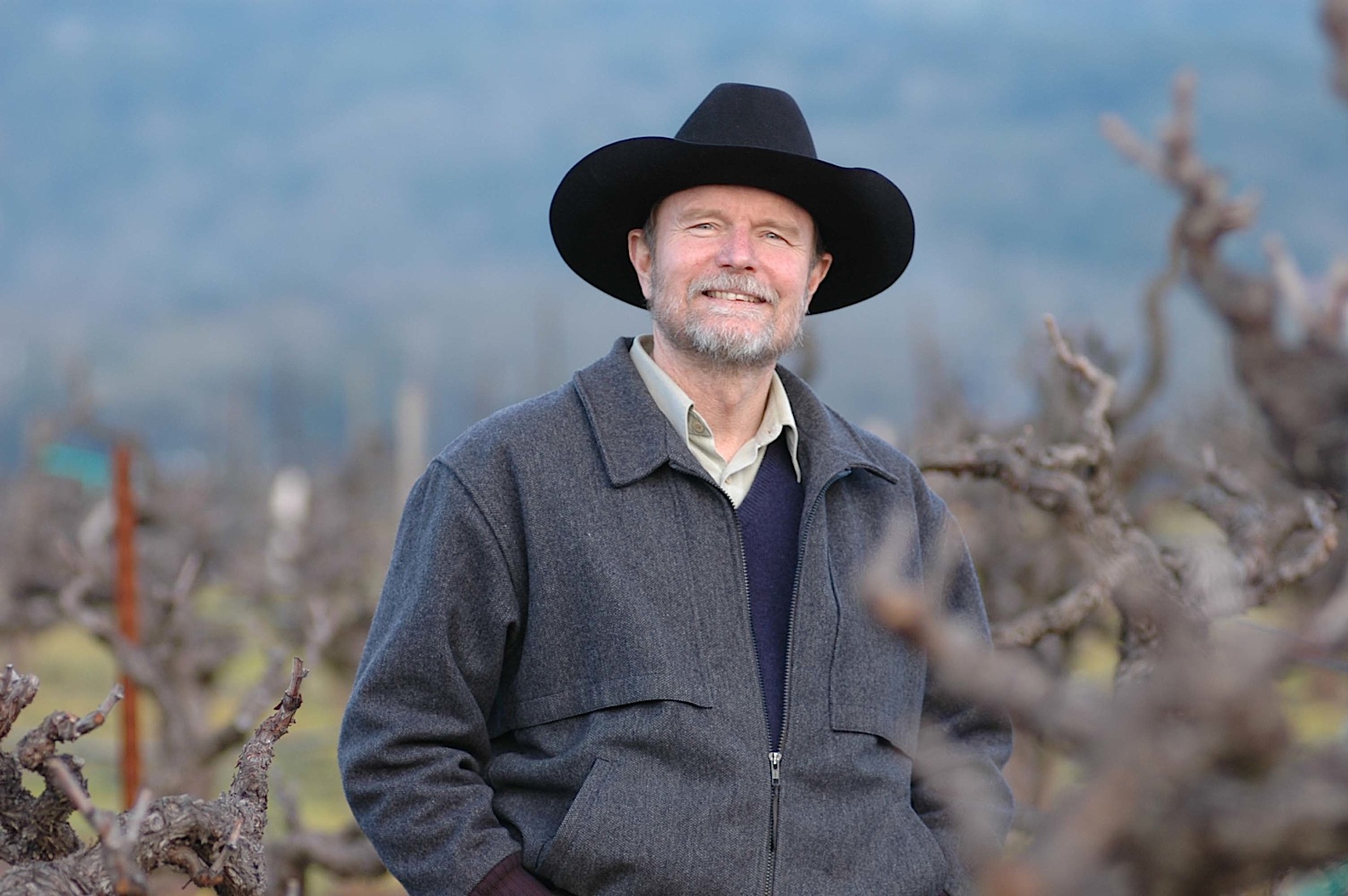 “I,
of course, have certain prejudices, because that’s the way my wines
have
always been,” he said. “I’ve been very careful about making wines
that I
think are balanced, that represent the place that the wines come
from.”
“I,
of course, have certain prejudices, because that’s the way my wines
have
always been,” he said. “I’ve been very careful about making wines
that I
think are balanced, that represent the place that the wines come
from.”
I recently had the chance to taste the range of Ravenswood’s 2007 Vineyard Series wines, and they beautifully embody exactly what Peterson is talking about. For despite the fact that you might assume more expensive, smaller-production zinfandels to find their footing on the flashier end of the spectrum, these were surprisingly restrained--each of them, despite their many and obvious differences, a nuanced, finely detailed expression of what the zinfandel grape variety does in a specific vineyard, a particular patch of the planet.
The sophisticated “Belloni” bottling showed cream, cherries, and warm clay on the nose, as well as particularly gentle pink and black peppercorn and a whiff of cigar humidor. These led to sweet notes of blackberry and wild-berry compote kept in check by layers of spice, a touch of flowers, and gorgeous balancing acidity.
The “Dickerson,” on the other hand, was a bit weightier, more muscled on the nose. Wild strawberries and kirsch, with licorice and balsamic in the background, precede a mouth-filling, exuberant palate of chocolate-covered blueberries, other mixed summertime berries, and, thoroughly unexpected, a flavor that reminded me, somehow, of deeply concentrated dark watermelon juice. With its richly expressive ripeness and lingering finish, this is a textbook example of how elegant zinfandel can be.
From
the Dry Creek Valley, the “Teldeschi” finds its footing on
the other
end of the spectrum: It’s at a quiet phase right now, the tannins still
dominating strawberry and dark raspberry fruit. There are intriguing
hints of
thyme-dominated garrigue, oolong tea and peppercorns, and with air the
sweetness of the fruit comes out. Still, I’d hold onto this one for
another 3+
years to allow it to emerge into a more mature state. Once it gets
there,
however, it should be delicious.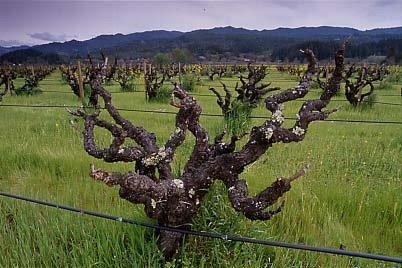
The “Old Hill” zinfandel will also continue to evolve for another several years, but it’s already showing its stuff beautifully right now with kirsch-filled chocolates, violets, and licorice. This is a wine that wears its power with remarkable elegance, as is the “Barricia,” which was perhaps my favorite among the 2007s, smelling of perfumed, roasted and gently smoked blackberries and blueberries, birch bark, and brown spices, and tastes of sun-warmed wild strawberries, dates, cigar tobacco, and kirsch. The finish, which lasts for well over 30 seconds, nods in the direction of cardamom and sweet dark cherries, and absolutely demands another sip, and another, and another.
Then, finally, there’s the “Big River,” which reminds me of a more sophisticated version of the classic, fleshy California zinfandel with its Sachertorte, cream, and toast notes cut with spice and acid that manages to keep this generous wine in harmony and balance. For zinfandel lovers--and, frankly, simply for fans of well-made wine that express a sense of terroir and varietal specificity—these Single Vineyard Designate, bottlings from Ravenswood are hard to beat. They’re both true to the land from which they come, and to the philosophy that has guided Joel Peterson ever since his maiden voyage with the 1976 vintage. Thank goodness he’s no longer in immunology research; we’re all drinking infinitely better as a result of the chance he took all those years ago.

As a joke
referring to recent rising water levels caused by rain in the Ohio
River, Kathy Kinane and her husband walked into the Waterfront
restaurant (right) on a barge
in Lexington, KY, wearing snorkeling outfits, and soon found the
restaurant had broken from its moorings and floated downriver, carrying
them and 81 others along 30 miles down river before being rescued. "We
were joking about the river," Kathy Kinane told media. "Well, the
joke's on us now."
 WELL, EXCEPT FOR THE DOG
FOOD,
WELL, EXCEPT FOR THE DOG
FOOD,
WHAT'S NOT TO LOVE?
Police investigated a possible hazing incident at the University of Virginia after a 19-year-old first year student became sick and was rushed to the hospital after eating dog food, matzo balls, gefilte fish and soy sauce. The student was pledging at Zeta Psi fraternity, had a seizure, and spent four days in the hospital, treated for an electrolyte imbalance caused by the high sodium content of the 12 to 18 ounces of soy sauce consumed. An investigator wrote that a Zeta Psi member said the meal is a tradition for pledges. . . . Meanwhile in Germany: While promoting their film "Marley & Me," stars Jennifer Aniston and Owen Wilson ate dog biscuits on the live television show, "Wetten, dass...?" ("Wanna bet?")
❖❖❖
Mariani's Quick Bytes
If you would like to be featured in our Quick Bytes section please visit out advertisement page at www.JohnMarianiMedia.com
|
Tattered Cover
on Colfax
On May 31 at Tattered Cover on
Colfax in Denver, CO,
Melissa Coleman
will read from This Life Is in Your Hands: One Dream, Sixty Acres, and
a Family Undone, a memoir that takes place during the early days of the
natural living and organic food movements. Tattered Cover 303-322-7727,
or visit www.melissacoleman.com
|
|
Corkbar
On April 27 from 6 p.m. to close
Corkbar hosts a “Sausage
Supper” with artisan purveyor Huntington Meats. Three-course, $25
prix-fixe menu with each dish featuring sausage from the local butcher.
Co-Owner Jim Cascone will be on hand to greet guests and answer
questions. A $10 beer pairing includes Lagunitas Brewing Company’s
PILS, Mad River Brewing Company’s Steelhead Extra Pale Ale, and
AleSmith Brewing Company’s IPA. A $15 wine pairing features two-ounce
pours of Qupé Marsanne, Santa Ynez Valley, 2009; Straight Line
Wine
Syrah, Santa Barbara County, 2009; and Genuine Risk Cabernet Sauvignon,
Santa Ynez Valley, 2009.
|
|
Tibetan Aid Project
On June 1 at the Arader
Gallery in New York, NY
the Tibetan Aid Project will host the benefit gala Taste & Tribute
in efforts to support the cultural and spiritual heritage of
Tibet. Guests will enjoy an exquisite four-course meal prepared
by a superbly talented team of New York chefs including Missy Robbins,
George Mendes, Gavin Kaysen, and Michael Laiskonis. There will
also be a live auction which will feature Tibetan artwork and luxurious
getaways. $475 pp. Visit www.TibetanAidProject.org
|
|
Powell's Books
on Hawthorne
On June 6 at Powell's Books on
Hawthorne in Portland, OR,
Melissa
Coleman will read from This Life Is in Your Hands: One Dream, Sixty
Acres, and a Family Undone, a memoir that takes place during the early
days of the natural living and organic food movements. Powell's
503-228-4651, or visit www.melissacoleman.com
|
Place your Quick Byte Here |
Any of John Mariani's books below
may be ordered from amazon.com.
"Equal
parts
history,
sociology,
gastornomy,
and
just
plain
fun,
How
Italian
Food
Conquered
the
World
tells
the
captivating
and
delicious
story
of
the
(let's
face
it)
everybody's
favorite
cuisine
with
clarity,
verve
and
more than one surprise."--Colman Andrews, editorial director of The Daily Meal.com. "A
fantastic and fascinating read, covering everything from the influence
of Venice's spice trade to the impact of Italian immigrants in
America and the evolution of alta cucina. This book will serve as a
terrific resource to anyone interested in the real story of Italian
food."--Mary Ann Espositio, hosty of PBS-TV's Ciao Italia. "John
Mariani
has
written
the
definitive
history
of
how
Italians
won
their
way
into
our
hearts,
minds,
and
stomachs.
It's
a
story
of
pleasure
over
pomp
and
taste
over
technique."--Danny
Meyer,
owner of
NYC restaurants Union Square Cafe, Gotham Bar & Grill, The Modern,
and Maialino.
|
 |
 |
 |
 |
 |
 |
 |
 |
 Everett
Potter's
Travel
Report:
Everett
Potter's
Travel
Report: 
 Eating
Las
Vegas is the new on-line site for Virtual Gourmet
contributor John
A. Curtas., who since 1995 has been commenting on the Las Vegas food
scene and reviewing restaurants for Nevada Public Radio. He is
also
the restaurant critic for KLAS TV, Channel 8 in Las Vegas, and his past
reviews can be accessed at KNPR.org.
Click
on
the
logo
below
to
go
directly
to
his
site.
Eating
Las
Vegas is the new on-line site for Virtual Gourmet
contributor John
A. Curtas., who since 1995 has been commenting on the Las Vegas food
scene and reviewing restaurants for Nevada Public Radio. He is
also
the restaurant critic for KLAS TV, Channel 8 in Las Vegas, and his past
reviews can be accessed at KNPR.org.
Click
on
the
logo
below
to
go
directly
to
his
site.

Tennis Resorts Online: A Critical Guide to the World's Best Tennis Resorts and Tennis Camps, published by ROGER COX, who has spent more than two decades writing about tennis travel, including a 17-year stretch for Tennis magazine. He has also written for Arthur Frommer's Budget Travel, New York Magazine, Travel & Leisure, Esquire, Money, USTA Magazine, Men's Journal, and The Robb Report. He has authored two books-The World's Best Tennis Vacations (Stephen Greene Press/Viking Penguin, 1990) and The Best Places to Stay in the Rockies (Houghton Mifflin, 1992 & 1994), and the Melbourne (Australia) chapter to the Wall Street Journal Business Guide to Cities of the Pacific Rim (Fodor's Travel Guides, 1991).


The Family Travel Forum
- A community for those who
"Have Kids, Still Travel" and want to make family vacations more fun,
less work and better value. FTF's travel and parenting features,
including
reviews of tropical and ski resorts, reunion destinations, attractions,
holiday
weekends, family festivals, cruises, and all kinds of vacation ideas
should be
the first port of call for family vacation planners. http://www.familytravelforum.com/index.html
ALL YOU NEED BEFORE YOU GO


MARIANI'S VIRTUAL GOURMET NEWSLETTER is published weekly. Editor/Publisher: John Mariani.
Contributing Writers: Christopher
Mariani, Robert Mariani,
John A. Curtas, Edward Brivio, Mort
Hochstein, Suzanne Wright, and
Brian Freedman. Contributing
Photographers: Galina Stepanoff-Dargery, Bobby Pirillo. Technical
Advisor:
Gerry McLoughlin.
Click Here to Return to John Mariani's
Homepage
© copyright John Mariani 2011
